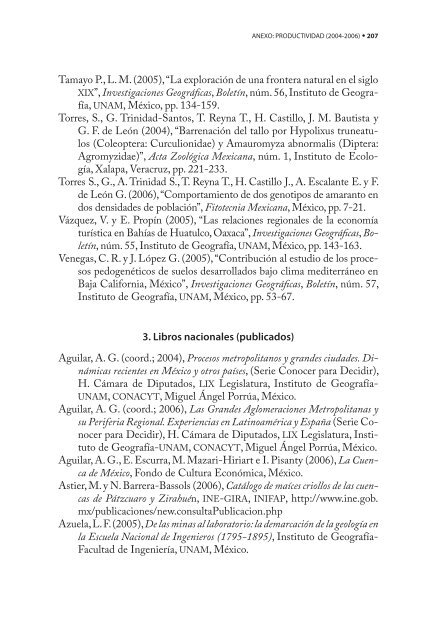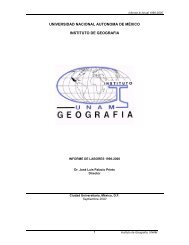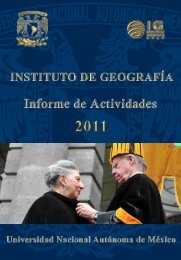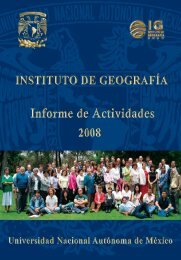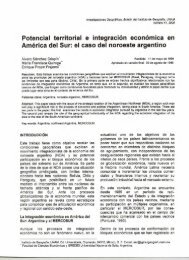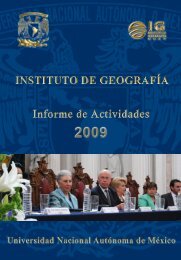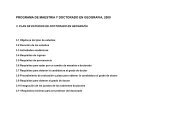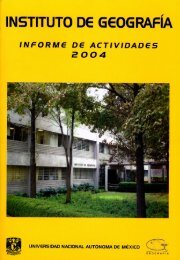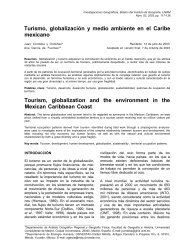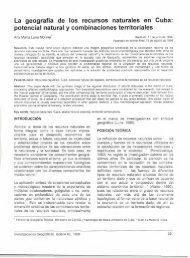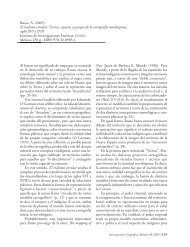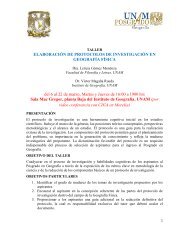206 . INSTITUTO DE GEOGRAFÍA-<strong>UNAM</strong>, INFORME DE ACTIVIDADES 2007Ortiz Álvarez, M. I. y R. Vidal Zepeda (2006), “Población expuesta a inviernosfríos en México”, Investigaciones Geográficas, Boletín, núm. 59,<strong>Instituto</strong> <strong>de</strong> Geografía, <strong>UNAM</strong>, México, pp. 93-112.Pichardo Hernán<strong>de</strong>z, H. y J. O. Moncada Maya (2006), “La laborgeográfica <strong>de</strong> Antonio García Cubas en el Ministerio <strong>de</strong> Hacienda,1868-1876”, Estudios <strong>de</strong> Historia Mo<strong>de</strong>rna y Contemporánea <strong>de</strong>México, núm. 31, enero-junio, pp. 83-107.Propín, E., Á. López López y Á. Sánchez Crispín (2004), “Territorios preferenciales<strong>de</strong> los grupos hoteleros internacionales en América Latinay el Caribe a principios <strong>de</strong>l siglo XXI”, Investigaciones Geográficas, Boletín,núm. 53, <strong>Instituto</strong> <strong>de</strong> Geografía, <strong>UNAM</strong>, México, pp. 122-140.Ramírez, M. I., M. Jiménez y A. Martínez (2005), “Estructura y <strong>de</strong>nsidad<strong>de</strong> la red <strong>de</strong> caminos en la Reserva <strong>de</strong> la Biosfera Mariposa Monarca”,Investigaciones Geográficas, Boletín, núm. 57, <strong>Instituto</strong> <strong>de</strong> Geografía,<strong>UNAM</strong>, México, pp. 68-80.Reyes Hernán<strong>de</strong>z, H., M. Aguilar Robledo, R. Aguirre Rivera e I. TrejoVázquez (2006), “Cambios en la cubierta y uso <strong>de</strong>l suelo en el área<strong>de</strong>l proyecto Pujal-Coy, San Luis Potosí, México”, InvestigacionesGeográficas, Boletín, núm. 59, <strong>Instituto</strong> <strong>de</strong> Geografía, <strong>UNAM</strong>, México,pp. 26-42.Rodríguez Gamiño, M. <strong>de</strong> L. y J. López Blanco (2006), “Caracterización<strong>de</strong> unida<strong>de</strong>s biofísicas a partir <strong>de</strong> indicadores ambientales en MilpaAlta Centro <strong>de</strong> México”, Investigaciones Geográficas, Boletín, núm. 60,<strong>Instituto</strong> <strong>de</strong> Geografía, <strong>UNAM</strong>, México, pp. 46-61.Sánchez, M. T., J. M. Casado y E. Saavedra Silva (2004), “La inversión privadaen el sector eléctrico en México: su marco institucional y estructuraterritorial”, Investigaciones Geográficas, Boletín, núm. 54, <strong>Instituto</strong><strong>de</strong> Geografía, <strong>UNAM</strong>, México, pp. 67-92.Sánchez-Salazar, M. T. y J. L. Palacio Prieto (2004), “La experiencia mexicanaen la elaboración <strong>de</strong> los planes estatales <strong>de</strong> or<strong>de</strong>namiento territorial.Diagnóstico, problemática y perspectivas <strong>de</strong>s<strong>de</strong> el punto <strong>de</strong> vista <strong>de</strong>la participación <strong>de</strong>l <strong>Instituto</strong> <strong>de</strong> Geografía”, Investigaciones Geográficas,Boletín, núm. 53, <strong>Instituto</strong> <strong>de</strong> Geografía, <strong>UNAM</strong>, México, pp. 75-97.Soria-Ruiz, J., Y. Fernán<strong>de</strong>z-Ordoñez and R. Granados-Ramírez (2005),“Methodology for prediction of corn yield using remote sensing satellitedata in Central Mexico”, Investigaciones Geográficas, Boletín,núm. 55, <strong>Instituto</strong> <strong>de</strong> Geografía, <strong>UNAM</strong>, México, pp. 61-68.Steffen, C. y F. Echánove (2005), “El mo<strong>de</strong>lo neoliberal y el difícil procesoorganizativo que viven los ejidatarios mexicanos productores <strong>de</strong> granos”,Polis 1, Universidad Autónoma Metropolitana, 1, pp. 211-233.
ANEXO: PRODUCTIVIDAD (2004-2006) . 207Tamayo P., L. M. (2005), “La exploración <strong>de</strong> una frontera natural en el sigloXIX”, Investigaciones Geográficas, Boletín, núm. 56, <strong>Instituto</strong> <strong>de</strong> Geografía,<strong>UNAM</strong>, México, pp. 134-159.Torres, S., G. Trinidad-Santos, T. Reyna T., H. Castillo, J. M. Bautista yG. F. <strong>de</strong> León (2004), “Barrenación <strong>de</strong>l tallo por Hypolixus truneatulos(Coleoptera: Curculionidae) y Amauromyza abnormalis (Diptera:Agromyzidae)”, Acta Zoológica Mexicana, núm. 1, <strong>Instituto</strong> <strong>de</strong> Ecología,Xalapa, Veracruz, pp. 221-233.Torres S., G., A. Trinidad S., T. Reyna T., H. Castillo J., A. Escalante E. y F.<strong>de</strong> León G. (2006), “Comportamiento <strong>de</strong> dos genotipos <strong>de</strong> amaranto endos <strong>de</strong>nsida<strong>de</strong>s <strong>de</strong> población”, Fitotecnia Mexicana, México, pp. 7-21.Vázquez, V. y E. Propín (2005), “Las relaciones regionales <strong>de</strong> la economíaturística en Bahías <strong>de</strong> Huatulco, Oaxaca”, Investigaciones Geográficas, Boletín,núm. 55, <strong>Instituto</strong> <strong>de</strong> Geografía, <strong>UNAM</strong>, México, pp. 143-163.Venegas, C. R. y J. López G. (2005), “Contribución al estudio <strong>de</strong> los procesospedogenéticos <strong>de</strong> suelos <strong>de</strong>sarrollados bajo clima mediterráneo enBaja California, México”, Investigaciones Geográficas, Boletín, núm. 57,<strong>Instituto</strong> <strong>de</strong> Geografía, <strong>UNAM</strong>, México, pp. 53-67.3. Libros nacionales (publicados)Aguilar, A. G. (coord.; 2004), Procesos metropolitanos y gran<strong>de</strong>s ciuda<strong>de</strong>s. Dinámicasrecientes en México y otros países, (Serie Conocer para Decidir),H. Cámara <strong>de</strong> Diputados, LIX Legislatura, <strong>Instituto</strong> <strong>de</strong> Geografía-<strong>UNAM</strong>, CONACYT, Miguel Ángel Porrúa, México.Aguilar, A. G. (coord.; 2006), Las Gran<strong>de</strong>s Aglomeraciones Metropolitanas ysu Periferia Regional. Experiencias en Latinoamérica y España (Serie Conocerpara Decidir), H. Cámara <strong>de</strong> Diputados, LIX Legislatura, <strong>Instituto</strong><strong>de</strong> Geografía-<strong>UNAM</strong>, CONACYT, Miguel Ángel Porrúa, México.Aguilar, A. G., E. Escurra, M. Mazari-Hiriart e I. Pisanty (2006), La Cuenca<strong>de</strong> México, Fondo <strong>de</strong> Cultura Económica, México.Astier, M. y N. Barrera-Bassols (2006), Catálogo <strong>de</strong> maíces criollos <strong>de</strong> las cuencas<strong>de</strong> Pátzcuaro y Zirahuén, INE-GIRA, INIFAP, http://www.ine.gob.mx/publicaciones/new.consultaPublicacion.phpAzuela, L. F. (2005), De las minas al laboratorio: la <strong>de</strong>marcación <strong>de</strong> la geología enla Escuela Nacional <strong>de</strong> Ingenieros (1795-1895), <strong>Instituto</strong> <strong>de</strong> Geografía-Facultad <strong>de</strong> Ingeniería, <strong>UNAM</strong>, México.
- Page 1 and 2:
UNIVERSIDAD NACIONAL AUTóNOMA DE M
- Page 3 and 4:
Universidad Nacional Autónoma de M
- Page 5 and 6:
COMISIÓN DICTAMINADORADr. Zoltan d
- Page 7 and 8:
COMISIÓN EVALUADORA PRIDE-PAIPADr.
- Page 9 and 10:
CONTENIDOPRESENTACIÓN 13I. Introdu
- Page 11 and 12:
4. Tesis presentadas 127a) Licencia
- Page 13 and 14:
PRESENTACIÓN . 13PRESENTACIÓNEste
- Page 15 and 16:
INTRODUCCIÓN . 15I. INTRODUCCIÓNE
- Page 17 and 18:
INTRODUCCIÓN . 173. Misión actual
- Page 19 and 20:
PLAN DE DESARROLLO DEL INSTITUTO DE
- Page 21 and 22:
PLAN DE DESARROLLO DEL INSTITUTO DE
- Page 23 and 24:
PERSONAL ACADÉMICO DEL INSTITUTO D
- Page 25 and 26:
PERSONAL ACADÉMICO DEL INSTITUTO D
- Page 27 and 28:
PERSONAL ACADÉMICO DEL INSTITUTO D
- Page 29 and 30:
PERSONAL ACADÉMICO DEL INSTITUTO D
- Page 31 and 32:
PERSONAL ACADÉMICO DEL INSTITUTO D
- Page 33 and 34:
PERSONAL ACADÉMICO DEL INSTITUTO D
- Page 35 and 36:
PERSONAL ACADÉMICO DEL INSTITUTO D
- Page 37 and 38:
PERSONAL ACADÉMICO DEL INSTITUTO D
- Page 39 and 40:
PERSONAL ACADÉMICO DEL INSTITUTO D
- Page 41 and 42:
PERSONAL ACADÉMICO DEL INSTITUTO D
- Page 43 and 44:
PERSONAL ACADÉMICO DEL INSTITUTO D
- Page 45 and 46:
PERSONAL ACADÉMICO DEL INSTITUTO D
- Page 47 and 48:
PERSONAL ACADÉMICO DEL INSTITUTO D
- Page 49 and 50:
PERSONAL ACADÉMICO DEL INSTITUTO D
- Page 51 and 52:
PERSONAL ACADÉMICO DEL INSTITUTO D
- Page 53 and 54:
PERSONAL ACADÉMICO DEL INSTITUTO D
- Page 55 and 56:
PRODUCTIVIDAD . 55Gibson, R. W., M.
- Page 57 and 58:
PRODUCTIVIDAD . 57Carrillo-Rivera,
- Page 59 and 60:
PRODUCTIVIDAD . 59Moncada Maya, J.
- Page 61 and 62:
PRODUCTIVIDAD . 61García, S. y Á.
- Page 63 and 64:
PRODUCTIVIDAD . 63Medina, C., A. Ve
- Page 65 and 66:
PRODUCTIVIDAD . 65Aguirre-Gómez, R
- Page 67 and 68:
PRODUCTIVIDAD . 67Chías Becerril,
- Page 69 and 70:
PRODUCTIVIDAD . 69Padilla y Sotelo,
- Page 71 and 72:
PRODUCTIVIDAD . 71Azuela, L. F.,
- Page 73 and 74:
PRODUCTIVIDAD . 73González Sánche
- Page 75 and 76:
PRODUCTIVIDAD . 75Sánchez Salazar,
- Page 77 and 78:
PRODUCTIVIDAD . 77Cervini-Silva, J,
- Page 79 and 80:
PRODUCTIVIDAD . 79González-Ramíre
- Page 81 and 82:
PRODUCTIVIDAD . 81Orozco Ramírez,
- Page 83 and 84:
PRODUCTIVIDAD . 83Cuevas, G. and J.
- Page 85 and 86:
PRODUCTIVIDAD . 85Gutiérrez-Ruiz,
- Page 87 and 88:
PRODUCTIVIDAD . 87Zavala Hidalgo, J
- Page 89 and 90:
PRODUCTIVIDAD . 89Hernández-Pineda
- Page 91 and 92:
PRODUCTIVIDAD . 91Urquijo Torres, P
- Page 93 and 94:
PRODUCTIVIDAD . 93Tanarro-García,
- Page 95 and 96:
PRODUCTIVIDAD . 95Barrera-Bassols,
- Page 97 and 98:
PRODUCTIVIDAD . 97Larrazábal, A. (
- Page 99 and 100:
PRODUCTIVIDAD . 99Carmona, E., “G
- Page 101 and 102:
PRODUCTIVIDAD . 10113. Nuevo Atlas
- Page 103 and 104:
PRODUCTIVIDAD . 103Agroclimatologí
- Page 105 and 106:
PRODUCTIVIDAD . 105Instituto de Inv
- Page 107 and 108:
ACTUALIZACIÓN . 107V. ACTUALIZACI
- Page 109 and 110:
ACTUALIZACIÓN . 109(IMGA), United
- Page 111 and 112:
ACTUALIZACIÓN . 111• Orta Pérez
- Page 113 and 114:
DOCENCIA Y FORMACIÓN DE RECURSOS H
- Page 115 and 116:
DOCENCIA Y FORMACIÓN DE RECURSOS H
- Page 117 and 118:
DOCENCIA Y FORMACIÓN DE RECURSOS H
- Page 119 and 120:
DOCENCIA Y FORMACIÓN DE RECURSOS H
- Page 121 and 122:
DOCENCIA Y FORMACIÓN DE RECURSOS H
- Page 123 and 124:
DOCENCIA Y FORMACIÓN DE RECURSOS H
- Page 125 and 126:
DOCENCIA Y FORMACIÓN DE RECURSOS H
- Page 127 and 128:
DOCENCIA Y FORMACIÓN DE RECURSOS H
- Page 129 and 130:
DOCENCIA Y FORMACIÓN DE RECURSOS H
- Page 131 and 132:
DOCENCIA Y FORMACIÓN DE RECURSOS H
- Page 133 and 134:
DOCENCIA Y FORMACIÓN DE RECURSOS H
- Page 135 and 136:
DOCENCIA Y FORMACIÓN DE RECURSOS H
- Page 137 and 138:
DOCENCIA Y FORMACIÓN DE RECURSOS H
- Page 139 and 140:
DOCENCIA Y FORMACIÓN DE RECURSOS H
- Page 141 and 142:
DOCENCIA Y FORMACIÓN DE RECURSOS H
- Page 143 and 144:
DOCENCIA Y FORMACIÓN DE RECURSOS H
- Page 145 and 146:
DOCENCIA Y FORMACIÓN DE RECURSOS H
- Page 147 and 148:
DOCENCIA Y FORMACIÓN DE RECURSOS H
- Page 149 and 150:
DOCENCIA Y FORMACIÓN DE RECURSOS H
- Page 151 and 152:
DOCENCIA Y FORMACIÓN DE RECURSOS H
- Page 153 and 154:
DOCENCIA Y FORMACIÓN DE RECURSOS H
- Page 155 and 156: DOCENCIA Y FORMACIÓN DE RECURSOS H
- Page 157 and 158: DOCENCIA Y FORMACIÓN DE RECURSOS H
- Page 159 and 160: VINCULACIÓN . 159VII. VINCULACIÓN
- Page 161 and 162: VINCULACIÓN . 161Posgrado Centroam
- Page 163 and 164: VINCULACIÓN . 163• Universidad T
- Page 165 and 166: INTERCAMBIO ACADÉMICO . 1651. Prof
- Page 167 and 168: PROGRAMA EDITORIAL . 167IX. Program
- Page 169 and 170: PROGRAMA EDITORIAL . 169Igualmente
- Page 171 and 172: BIBLIOTECA-MAPOTECA . 171• Actual
- Page 173 and 174: BIBLIOTECA-MAPOTECA . 1732. Procesa
- Page 175 and 176: BIBLIOTECA-MAPOTECA . 175• Reunio
- Page 177 and 178: BIBLIOTECA-MAPOTECA . 177• Orient
- Page 179 and 180: BIBLIOTECA-MAPOTECA . 17912. Horari
- Page 181 and 182: SECRETARÍA ADMINISTRATIVA . 181Xi.
- Page 183 and 184: SECRETARÍA ADMINISTRATIVA . 183Est
- Page 185 and 186: SECRETARÍA ADMINISTRATIVA . 185Ing
- Page 187 and 188: SECRETARÍA ADMINISTRATIVA . 187IN-
- Page 189 and 190: SECRETARÍA ADMINISTRATIVA . 189Pro
- Page 191: AnexoProductividad(2004-2006)
- Page 194 and 195: 194 . INSTITUTO DE GEOGRAFÍA-UNAM,
- Page 196 and 197: 196 . INSTITUTO DE GEOGRAFÍA-UNAM,
- Page 198 and 199: 198 . INSTITUTO DE GEOGRAFÍA-UNAM,
- Page 200 and 201: 200 . INSTITUTO DE GEOGRAFÍA-UNAM,
- Page 202 and 203: 202 . INSTITUTO DE GEOGRAFÍA-UNAM,
- Page 204 and 205: 204 . INSTITUTO DE GEOGRAFÍA-UNAM,
- Page 208 and 209: 208 . INSTITUTO DE GEOGRAFÍA-UNAM,
- Page 210 and 211: 210 . INSTITUTO DE GEOGRAFÍA-UNAM,
- Page 212 and 213: 212 . INSTITUTO DE GEOGRAFÍA-UNAM,
- Page 214 and 215: 214 . INSTITUTO DE GEOGRAFÍA-UNAM,
- Page 216 and 217: 216 . INSTITUTO DE GEOGRAFÍA-UNAM,
- Page 218 and 219: 218 . INSTITUTO DE GEOGRAFÍA-UNAM,
- Page 220 and 221: 220 . INSTITUTO DE GEOGRAFÍA-UNAM,
- Page 222 and 223: 222 . INSTITUTO DE GEOGRAFÍA-UNAM,
- Page 224 and 225: 224 . INSTITUTO DE GEOGRAFÍA-UNAM,
- Page 226 and 227: 226 . INSTITUTO DE GEOGRAFÍA-UNAM,
- Page 228 and 229: 228 . INSTITUTO DE GEOGRAFÍA-UNAM,
- Page 230 and 231: 230 . INSTITUTO DE GEOGRAFÍA-UNAM,
- Page 232 and 233: 232 . INSTITUTO DE GEOGRAFÍA-UNAM,
- Page 234 and 235: 234 . INSTITUTO DE GEOGRAFÍA-UNAM,
- Page 236 and 237: 236 . INSTITUTO DE GEOGRAFÍA-UNAM,
- Page 238 and 239: 238 . INSTITUTO DE GEOGRAFÍA-UNAM,
- Page 240 and 241: 240 . INSTITUTO DE GEOGRAFÍA-UNAM,
- Page 242 and 243: 242 . INSTITUTO DE GEOGRAFÍA-UNAM,
- Page 244 and 245: 244 . INSTITUTO DE GEOGRAFÍA-UNAM,
- Page 246 and 247: 246 . INSTITUTO DE GEOGRAFÍA-UNAM,
- Page 248 and 249: 248 . INSTITUTO DE GEOGRAFÍA-UNAM,
- Page 250 and 251: 250 . INSTITUTO DE GEOGRAFÍA-UNAM,
- Page 252 and 253: 252 . INSTITUTO DE GEOGRAFÍA-UNAM,
- Page 254 and 255: 254 . INSTITUTO DE GEOGRAFÍA-UNAM,
- Page 256 and 257:
256 . INSTITUTO DE GEOGRAFÍA-UNAM,
- Page 258 and 259:
258 . INSTITUTO DE GEOGRAFÍA-UNAM,
- Page 260 and 261:
260 . INSTITUTO DE GEOGRAFÍA-UNAM,
- Page 262 and 263:
262 . INSTITUTO DE GEOGRAFÍA-UNAM,
- Page 264 and 265:
264 . INSTITUTO DE GEOGRAFÍA-UNAM,
- Page 266 and 267:
266 . INSTITUTO DE GEOGRAFÍA-UNAM,
- Page 268 and 269:
268 . INSTITUTO DE GEOGRAFÍA-UNAM,
- Page 270 and 271:
270 . INSTITUTO DE GEOGRAFÍA-UNAM,
- Page 272 and 273:
272 . INSTITUTO DE GEOGRAFÍA-UNAM,
- Page 274 and 275:
274 . INSTITUTO DE GEOGRAFÍA-UNAM,
- Page 276 and 277:
276 . INSTITUTO DE GEOGRAFÍA-UNAM,
- Page 278 and 279:
278 . INSTITUTO DE GEOGRAFÍA-UNAM,


